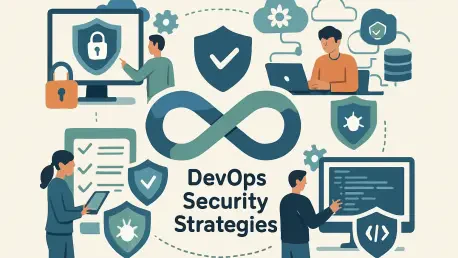In the ever-evolving landscape of enterprise SaaS technology, Vijay Raina stands as a beacon of expertise. As a specialist in both software design and DevOps architecture, his insights shed light on how modern enterprises can navigate the complexities and security challenges of DevOps pipelines. In this interview, we delve into the intricate world of DevOps, exploring its vulnerabilities, the risks it introduces, and strategies for bolstering security throughout the development cycle.
Can you explain what a DevOps pipeline is and how it operates?
A DevOps pipeline is essentially an automated process that facilitates the continuous integration and continuous delivery (CI/CD) of software. It encompasses multiple stages—from code compilation and testing to deployment. The pipeline manages the flow of code changes through various environments, enabling rapid iteration and deployment. However, each integration point, whether a code repository or a deployment server, is a potential entry point for security vulnerabilities. These vulnerabilities can arise from misconfigurations or inadequate security practices.
What makes DevOps pipelines attractive targets for cybercriminals?
The allure of DevOps pipelines for cybercriminals lies in their expansive attack surface and the valuable assets flowing through them regularly. They enable attackers to exploit multiple entry points, often with minimal oversight, allowing them to bypass traditional security measures effortlessly. The automation of these processes can inadvertently provide a smooth path for malicious activities if security isn’t baked into every step of the pipeline.
What problems arise from leaked credentials in DevOps environments?
Leaked credentials pose a severe security risk, leading to unauthorized access to sensitive data and critical systems. This often happens when secrets are hardcoded into repositories and configuration files, turning them into ticking time bombs. The exposure can potentially grant attackers administrative access to systems, leading to devastating breaches. Organizations need robust secret management practices to safeguard these credentials and reduce leakage risks.
What is meant by supply chain infiltration and how does it impact DevOps pipelines?
Supply chain infiltration refers to the compromise of tools or components that are part of the software development lifecycle, leading to widespread impact. It’s a potent attack vector where tampering with a single component can affect numerous organizations. Incidents like the SolarWinds and Codecov breaches are prime examples. They highlight how compromising a trusted tool can lead to a cascade of security breaches across the ecosystem, emphasizing the importance of securing every element within the pipeline.
How do open-source dependencies pose risks in DevOps pipelines?
Open-source dependencies are a double-edged sword in DevOps pipelines. While they speed up development, they also introduce vulnerabilities due to potential unpatched or malicious packages. This “dependency chaos” can expose pipelines to security risks if not properly vetted and continuously monitored. Organizations must implement rigorous software composition analysis to manage and mitigate these risks effectively.
What are the consequences of excessive privileges in DevOps processes?
Excessive privileges can lead to disastrous security breaches, allowing unauthorized users to modify critical systems or access sensitive data. This lack of stringent access controls undermines security principles and paves the way for privilege escalation attacks. Organizations should enforce least privilege access policies to limit what each user or service account can do, thereby minimizing potential damage.
Why is there often a lack of security testing in pipeline infrastructure?
Security testing in pipeline infrastructure is often overlooked because the focus traditionally remains on the application code. This creates a blind spot, allowing attackers to exploit pipeline weaknesses like misconfigurations or untested third-party integrations. Integrating security testing tools directly into the pipeline can help identify and fix these vulnerabilities before they can be exploited.
Can you discuss the Codecov breach and its significance to DevOps security?
The Codecov breach was a stark reminder of the vulnerabilities inherent in the software supply chain. Attackers compromised the Bash uploader script, turning a trusted tool into a means of credential theft. This incident underscored the systemic risks of relying on external software components and the importance of continuous validation of security in trusted tools. It emphasized the need for vigilant monitoring and auditing of the supply chain within DevOps environments.
What strategies can be employed to embed security into every stage of the DevOps process?
Embedding security in the DevOps process requires a multi-layered approach. It must start with integrating security checks at every phase, from code reviews for vulnerabilities to automated tests that validate security assumptions. Implementing a zero trust architecture is crucial; it treats all components as potentially compromised and requires rigorous authentication and monitoring. Additionally, cultivating a culture of security awareness among all team members ensures everyone plays a part in maintaining the integrity of the pipeline.
How can organizations cultivate a culture of security consciousness among developers and DevOps engineers?
Cultivating security consciousness involves consistent education and training. Organizations should instill security best practices as foundational elements of the development lifecycle. By teaching developers to recognize risks and empowering DevOps engineers with the knowledge to implement secure configurations, security becomes an instinctive part of the workflow. Continuous learning and proactive awareness are pivotal to maintaining cybersecurity in evolving DevOps practices.
How should organizations prepare for potential attacks on their DevOps infrastructure?
Preparation for potential attacks requires a proactive stance, starting with robust monitoring systems to detect anomalies and unauthorized access rapidly. Real-time alerts and comprehensive breach response plans are vital to containing and resolving incidents swiftly. Key aspects include constant vigilance and a dynamic response strategy that evolves as new threats emerge, ensuring resilient protection in this fast-paced digital realm. What are the key aspects of detecting and responding to breaches in a high-speed digital landscape?









